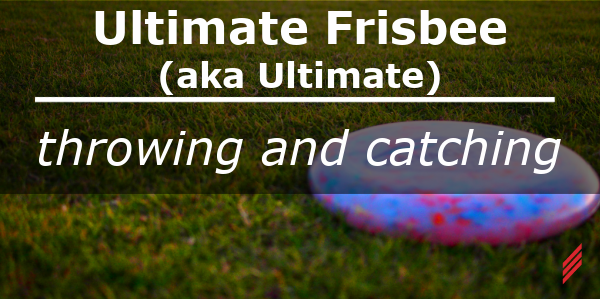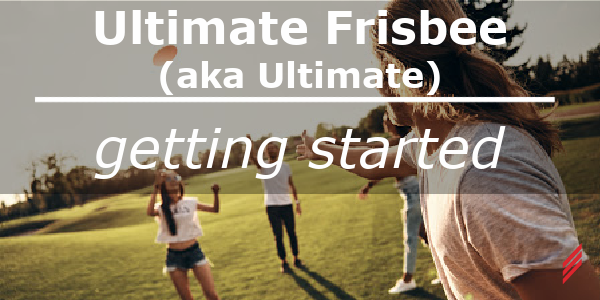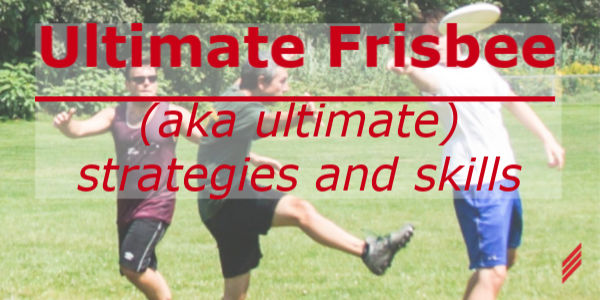Ultimate Frisbee (aka, Ultimate)-Throwing & Catching
by Brenda Rose on Aug 5, 2021 10:30:00 AM

In my first two blogs, Ultimate Frisbee – Getting Started, and Ultimate Frisbee – Strategies & Skills, I shared some of the basic concepts of the game, and both offensive and defensive strategies. In this third blog you will learn about the bread & butter of ultimate Frisbee, throwing & catching.
Ultimate Frisbee (aka, Ultimate) Getting Started- Part 1
Ultimate Frisbee (aka, Ultimate) Strategies and Skills- Part 2
Ultimate Frisbee (aka, Ultimate) Throwing and Catching- Part 3
THROWING
It might seem odd that I would introduce this topic so late in this three part series on Ultimate Frisbee. However, understanding when and why to use certain throws in ultimate, is largely based on the defensive strategies introduced in the second blog, specifically Forcing. This should become clearer a little further down.
To be consistent with the rest of the ultimate community, as well as to cater to the majority of the population (sorry lefties), whenever a specific throw and/or force are discussed it is assumed the thrower is right handed.
The two main throws you must learn when throwing with a mark on (mark = defender on the thrower), are the backhand and forehand. Specifically, the outside-in (OI) version of these two throws, which will be discussed in more detail shortly.
Let’s start with the backhand, which is the most common way people throw a Frisbee. The disc is cupped with your right hand fingers, your index finger out for stability, and your thumb on top for support. You then bring the disc across the left side of your body, then unwind and release. Another option is to use what I like to call the power grip, where your index finger stays alongside your other fingers cupping the disc. I use the power grip for the pull.


Figure 1: Backhand Grip (left), Backhand Power Grip (right)
The forehand (flick) might feel awkward at first, and can be a little frustrating to learn. Don’t give up! Once you get it, you’ll be happy you put the effort into adding it to your bag of tricks. There are slightly different ways to grip the disc for this throw. I find it works best to place the right hand middle finger along the inside edge of the disc. The index finger stretches away from the middle finger towards the underside center of the disc to provide some stability. The thumb is then placed on top of the disc. The disc starts off relatively limp in your hand. With the elbow bent down towards the ground, and your right hand out to the right as if you were carrying a tray, flip your wrist back about 20 degrees, then flick your wrist forward and release the disc. Notice I didn’t mention using your arm? Although some arm movement is necessary, most of the power comes from the flick of the wrist. If you try to get more power from using more arm motion, you are likely to be disappointed with the results.


Figure 2: Forehand (flick)
To demonstrate the importance of knowing the two basic throws, two side by side examples are shown below. Defenders will position themselves to take away your throwing options. In the left side example, the mark is forcing home. The open side throw, or the easy throw, would be a backhand throw. In the example on the right, the thrower is in the same position, but the mark is now forcing away. The open side throw is now a forehand.
Figure 3: Forced to throw backhand (left), forced to throw forehand (right)
Now back to that outside-in throw. When you are throwing to the open side, you want to release the disc such that the disc arcs towards the outside and comes back in. The amount of arc you put on the disc depends on where your cutter and defender are positioned relative to the point of delivery.
Figure 4: Hitting the cutter on the outside shoulder
Break Throws
Hopefully now you have a good grasp on the basic throws. Time to shake things up a bit and introduce some break throws. A break throw is used to throw the defense off balance. They want to control the game by dictating where you can or cannot throw. The best way to counter that, is by getting a break throw off and watching the defense scramble to recover.
The inside-out (IO) version of the backhand and forehand are the first break throws we’ll discuss. The grip doesn’t change, however where and how you release the disc will be different than when you throw the outside-in. You want the inside-out to arc towards the inside and back out. If you are being forced backhand, you can use the inside-out backhand to break the mark. This is my favorite throw for initiating a play from a stopped disc. The player at the front of the stack doesn’t have to break a sweat to get open, and their defender will be on the wrong side to maintain the force. For a forehand force, the inside-out break throw would be a forehand.
Figure 5: Inside out backhand throw
The outside-in backhand and forehand can also be break throws. If you are being forced to throw backhand, the outside-in forehand can be used to break the mark, and vice versa. This throw is often used for the dump-swing play discussed in Skills & Strategies, part 2 of this blog.
You just learned about some more common throws used to break the mark in ultimate Frisbee, however any throw that delivers the Frisbee to the closed side of the field is considered a break throw.
THE HAMMER
Bust a move, it’s hammer time! No, not really. While the ability to spontaneously break out your best dance moves is great for building team spirit, no special dance skills are required for the Hammer, just a bit of practice. It is used to loft the disc over the defense. I’m usually on the receiving end of this throw because my mid-range hammer lacks accuracy. It is however my go-to throw for a short dump pass when the stall count is high.
How to execute the hammer? I often hear people describe the hammer as like throwing an axe. I’m not sure a large percentage of the population are experienced axe throwers, but hopefully that provides enough of a mental image to figure out it is an overhead throw. The grip is the same as for the forehand. Bring the disc up overhead and slightly tilted to the left. Keeping a bent elbow, pull the disc back and release forward as you bring the disc back over your head. The disc will start off angled, and should end upside down and flat.
Figure 6: Hammer
BLADE
The blade is a poorly executed hammer. It’s what happens when the disc does not flatten out. As you can imagine a disc coming at you vertically with some speed can be a little intimidating.
ADDITIONAL THROWS
Here are some additional throws used less frequently, but worth introducing nonetheless. Learning the basic throws really well is more important than learning these specialty throws, however they can still be fun to experiment with. If you decide to practice them in earnest, it is possible to learn to execute them with some amount of accuracy and finesse.
- High Release: There are high release versions of both the backhand and forehand. As you can imagine the release of the disc is at a higher point than the regular throw. There is more snap to the wrist, and it is best suited for short throws by tall people.
- Low Release: There is also a low release of both the backhand and forehand throw, where the disc is released low to the ground with a slight angle upward. This tends to be my natural method of throwing, perhaps because I’m lower to the ground to begin with. The drawback is that it takes a little longer to execute and recover from.
- Scoober: It is best described as a hammer released at shoulder height. This is a nice shorter range, quick throw.
- Thumber: This is similar to the hammer in that it starts off slightly angled, then flattens out. It is released more like a forehand with the disc upside down, and your thumb on top of the underside of the disc.
- Push Pass: My least favorite of them all. Seriously, I prefer a blade over a push pass. Alas, some people like to use this short wobbly throw. To execute the push pass, grip the disc as you would a backhand. You will keep the disc more toward the throwing side, and push the disc forward while rotating the disc clockwise. These are great for turnovers…I mean short quick passes.
CATCHING
Does catching really need its own dedicated section? How much can really be involved in catching a Frisbee? The answer is yes and probably a bit more than you would expect, respectively. There is undoubtedly a lot less skill required in catching a frisbee compared to throwing one, however there is some technique involved.
Let’s start with two handed catches. You should attempt to catch the disc with two hands whenever possible. It is tempting to catch with one hand when the disc doesn’t hit you right in the gut, however using both hands will increase your probability of a successful completion. If the disc is above your knees, just above your head or lower, and within arm’s length to your side, then use both hands!
The pancake catch and alligator catch both involve clapping your hands together with the disc in the middle. Elbows are bent for the pancake, whereas arms are straight out for the alligator. The pancake is the safest option for catching as you can easily bring the disc into your body as a buffer


Figure 7: Pancake (left), Alligator (right)
The claw catch might be a little less reliable than the pancake, but can be used when you need to stretch a little further to get to the disc before your defender. Hands out like two lobster claws, then clamp down on the disc!
Figure 8: Claw
There are times when two handed catches are not a viable option. This is when the disc is below your knees, far above your head, or greater than an arm’s length from your side. If the disc is on your right, catch with your right hand. If the disc is on your left, catch with your left hand. You might want to catch a one handed disc with whichever hand is dominant, regardless of where the disc is. This is not the most efficient way to catch, and will likely lead to more turnovers.
When the disc is high above your head, you will have to jump to catch it. Conversely, when the disc is lower to the ground and too far to reach, you might have to get horizontal with a layout. First turn off those self-preservation signals your brain is sending, then dive forward with hands stretched out in front of you. Ideally you will land chest first parallel to the ground. Think Superman. 
Figure 9: UVM Alumna Lauren Baecher Laying Out
If you’ve read the entire Ultimate Fribee blog series, you are now ready for prime time! You will be able to join a pickup game and talk the talk with the most experienced players. I hope you’ve enjoyed learning about my favorite sport, and perhaps it will lead you out to play. Have I mentioned there is a pickup game at Farrell Park, Wednesdays at noon?
About the Author
Brenda Rose is a Senior Controls Engineer with 17 years experience. Brenda obtained a Technologist degree in Mechatronics, a college program heavily influenced by the automotive industry. Her career has focused on controls engineering in manufacturing.
About Hallam-ICS
Hallam-ICS is an engineering and automation company that designs MEP systems for facilities and plants, engineers control and automation solutions, and ensures safety and regulatory compliance through arc flash studies, commissioning, and validation. Our offices are located in Massachusetts, Connecticut, New York, Vermont and North Carolina and our projects take us world-wide.
You May Also Like
These Related Stories

Ultimate Frisbee (aka, Ultimate)-Getting Started

Ultimate Frisbee (aka, Ultimate)-Strategies and Skills



Comments (1)